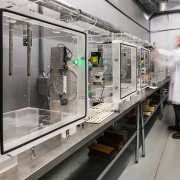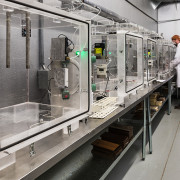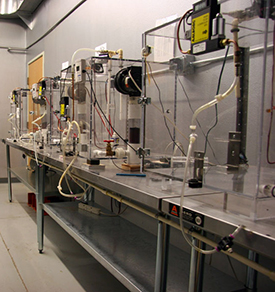Joint Industry Statement: 60 Minutes Report
Good Morning,
Please see the joint industry statement related to a 60 Minutes story about Lumber Liquidators and specifically concerning the utilized test methodology to measure formaldehyde. As the second accredited laboratory engaged by 60 Minutes for small chamber analysis of deconstructed flooring samples the attached statement is reflective of our opinion of the ARB SOP.
Without preference to any party involved in the 60 Minutes report and from a purely technical aspect, there exist nearly limitless production and processing variables that will impact the original emission profile of a regulated composite wood product. In current conversations taking place throughout the market there exists an assignment of explicit compliance with the emission requirements of the Airborne Toxic Control Measure. In our opinion this is an improper way to view any test result utilizing the ASTM D6007 test method – either when measuring emissions from a ‘raw’ regulated panel and especially from a ‘deconstructed’ regulated panel. From the ASTM D6007-14 method alone:
13. Precision and Bias
- 13.1 A study including seven laboratories and four test materials was conducted in accordance with Practice E691 and resulted in the following statements for precision and bias.
- 13.1.1 Repeatability – Test results indicate a repeatability (within laboratory) precision standard deviation ranging from 0.01 to 0.02 for products emitting 0.06 to 0.24 ppm of formaldehyde.
- 13.1.2 Reproducibility – Test results indicate a reproducibility (laboratory) precision standard deviation ranging from 0.02 to 0.05 for products emitting 0.06 to 0.24 ppm of formaldehyde, respectively.
We fully support the efforts of the California Air Resources Board to improve indoor air quality. Benchmark actively participates with the agency as changes are made to the CARB ATCM and we maintain an open door policy for members of the Air Resources Board to enter our laboratory at all times; the United States Environmental Protection Agency accepted the same offer and has spent time in our laboratory while promulgating the U.S. National Formaldehyde Regulation. Our concern for the quality of air in homes, offices, schools and commercial structures is now being extended into even more stringent regulatory schemes such as the California Department of Public Health Section 01350 which we cover through our VOC Green program. Indoor air quality is important and clean air benefits everyone.
The circumstances surrounding the current conversations and search for answers regarding the different test methods utilized by different entities has compelled us to provide this simple analysis – Precise, reproducible results from material tested using ASTM D6007 is difficult at best. The variability found in the 2013 CARB Interlaboratory Comparison (Benchmark ID: NN) demonstrates this.
We are not discounting the SOP as irrelevant, it can be used as a tool by technically competent and trained regulatory agencies to warrant further investigation into a product. We do not agree with the assignment of explicit ‘compliance’ or ‘non-compliance’ of a product when tested in this manner.
The opportunity to participate with a storied institution such as 60 Minutes was an honor for us. Each of us here can replay the voices of Safer, Cronkite, Rooney and many others which we heard so often growing up. Our decision to participate with this project came from a sense of responsibility that we needed to try our best to explain a highly complex environmental regulation and the test methods used – the ATCM has many nuances that are difficult to grasp. This statement too is born from a sense of responsibility – we are being bombarded with questions from every corner of the nation about this issue. Applying precise measurement techniques to an inhomogeneous product created in an imperfect manufacturing environment is impractical. The merits of the language of the ATCM can be argued by attorneys, politicians and regulators and is not a discussion we will enter. Opening a dialogue concerning the technical aspects of test methods used within the regulation is a discussion we have entered before and continue to participate in today.
Sincerely,
Travis R. Snapp
Managing Director, Benchmark International (BMI)
Chief Operating Officer, Benchmark Holdings (BMH)






 The
The  The EPA proposed two rules aimed at protecting the public from the risks associated with exposure to formaldehyde. The first proposal would implement formaldehyde emission standards under TSCA Title VI, and would apply to hardwood plywood, medium-density fiberboard, particleboard, and finished goods containing these products that are sold, supplied, offered for sale, or manufactured (including imported) in the United States.
The EPA proposed two rules aimed at protecting the public from the risks associated with exposure to formaldehyde. The first proposal would implement formaldehyde emission standards under TSCA Title VI, and would apply to hardwood plywood, medium-density fiberboard, particleboard, and finished goods containing these products that are sold, supplied, offered for sale, or manufactured (including imported) in the United States.
